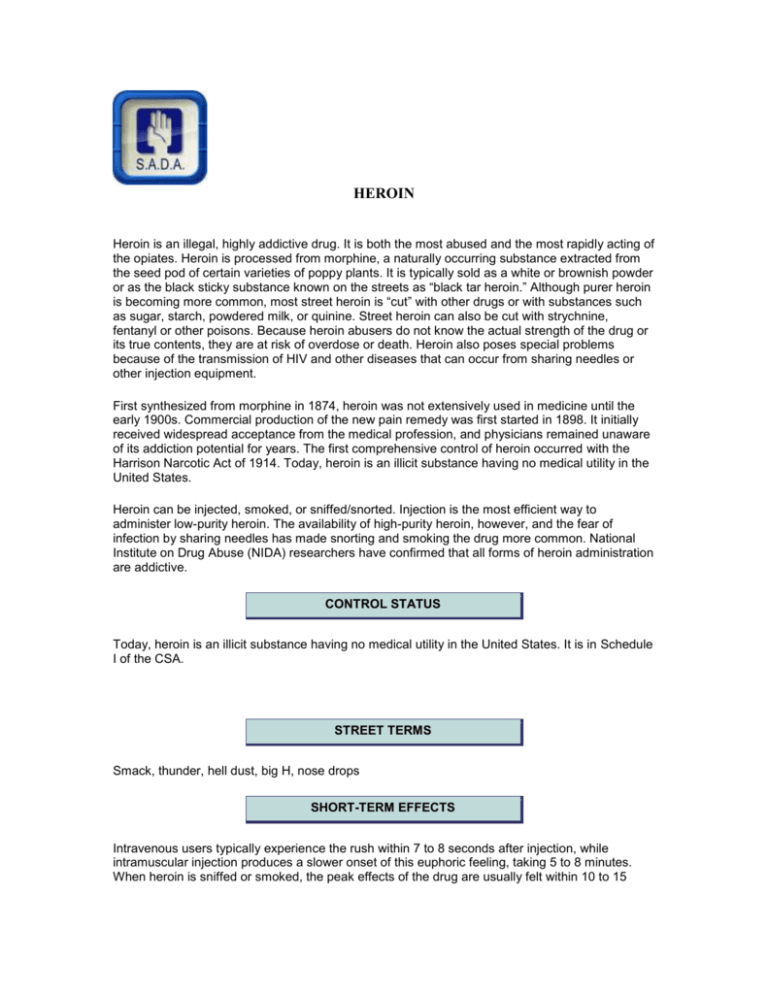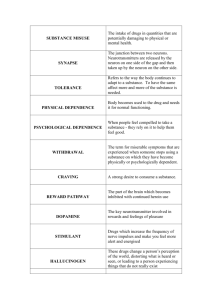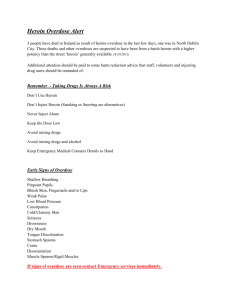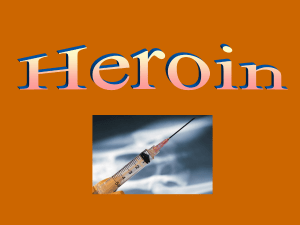Heroin
advertisement

HEROIN Heroin is an illegal, highly addictive drug. It is both the most abused and the most rapidly acting of the opiates. Heroin is processed from morphine, a naturally occurring substance extracted from the seed pod of certain varieties of poppy plants. It is typically sold as a white or brownish powder or as the black sticky substance known on the streets as “black tar heroin.” Although purer heroin is becoming more common, most street heroin is “cut” with other drugs or with substances such as sugar, starch, powdered milk, or quinine. Street heroin can also be cut with strychnine, fentanyl or other poisons. Because heroin abusers do not know the actual strength of the drug or its true contents, they are at risk of overdose or death. Heroin also poses special problems because of the transmission of HIV and other diseases that can occur from sharing needles or other injection equipment. First synthesized from morphine in 1874, heroin was not extensively used in medicine until the early 1900s. Commercial production of the new pain remedy was first started in 1898. It initially received widespread acceptance from the medical profession, and physicians remained unaware of its addiction potential for years. The first comprehensive control of heroin occurred with the Harrison Narcotic Act of 1914. Today, heroin is an illicit substance having no medical utility in the United States. Heroin can be injected, smoked, or sniffed/snorted. Injection is the most efficient way to administer low-purity heroin. The availability of high-purity heroin, however, and the fear of infection by sharing needles has made snorting and smoking the drug more common. National Institute on Drug Abuse (NIDA) researchers have confirmed that all forms of heroin administration are addictive. CONTROL STATUS Today, heroin is an illicit substance having no medical utility in the United States. It is in Schedule I of the CSA. STREET TERMS Smack, thunder, hell dust, big H, nose drops SHORT-TERM EFFECTS Intravenous users typically experience the rush within 7 to 8 seconds after injection, while intramuscular injection produces a slower onset of this euphoric feeling, taking 5 to 8 minutes. When heroin is sniffed or smoked, the peak effects of the drug are usually felt within 10 to 15 minutes. In addition to the initial feeling of euphoria, the short-term effects of heroin include a warm flushing of the skin, dry mouth, and heavy extremities. Heroin laced with fentanyl and other poisons have been known to cause death within hours. LONG-TERM EFFECTS Chronic users may develop collapsed veins, infection of the heart lining and valves, abscesses, cellulites, and liver disease. Pulmonary complications, including various types of pneumonia, may result from the poor health condition of the abuser, as well as from heroin's depressing effects on respiration. In addition to the effects of the drug itself, street heroin may have additives that do not really dissolve and result in clogging the blood vessels that lead to the lungs, liver, kidneys, or brain. This can cause infection or even death of small patches of cells in vital organs. One of the most significant effects of heroin use is addiction. With regular heroin use, tolerance to the drug develops. Once this happens, the abuser must use more heroin to achieve the same intensity or effect that they are seeking. As higher doses of the drug are used over time, physical dependence and addiction to the drug develop. Withdrawal, which in regular abusers may occur as early as a few hours after the last administration, produces drug craving, restlessness, muscle and bone pain, insomnia, diarrhea and vomiting, cold flashes with goose bumps (“cold turkey”), kicking movements (“kicking the habit”), and other symptoms. Major withdrawal symptoms peak between 48 and 72 hours after the last dose and subside after about a week. Sudden withdrawal by heavily dependent users who are in poor health is occasionally fatal, although heroin withdrawal is considered less dangerous than alcohol or barbiturate withdrawal.





